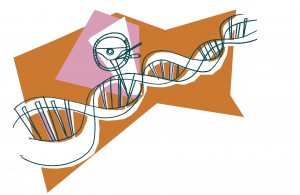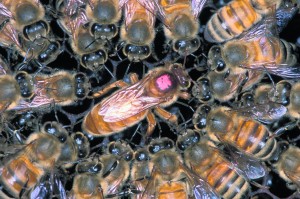MONDAY, 3 OCTOBER 2011
At the beginning of the 19th century, the Swedish parish of Overkalix experienced several winters of crop failure and with it widespread suffering and malnutrition. As it turns out, these unfortunate events may reveal a fascinating possibility almost two centuries later—the grandchildren of the young men who suffered a winter of starvation live considerably longer than average. Conversely, the grandchildren of individuals who were children during unusually fruitful years tend to have a much lower life expectancy. It seems that exposure to either a wealth or a paucity of food during an individual’s formative years can leave some sort of imprint that affects their descendants, impacting on the life expectancy of their grandchildren over 100 years later. Is it possible that something a parent experiences can alter the traits of their descendants?Long before Charles Darwin’s theory of evolution by natural selection came to prominence, another theory held sway. The French naturalist Jean Baptiste de Lamarck believed in the ‘inheritance of acquired characters’. That is, that an organism’s life experiences could be passed on to their offspring. An oft cited example is that of giraffes which, according to Lamarck, evolved lengthy necks through the very act of constantly stretching for the highest leaves. However, Lamarck’s ideas have been largely dismissed. One problem is that while the giraffe may stretch its neck, only its germ cells (sperm and egg) are passed on to offspring. Is there any way these completely separate cells know the neck has been stretched? Likewise, it has long been clear that while smoking or over-eating may impinge your own health, future generations will start afresh, unaffected by their parents past digressions. Children of smokers, for example, are not born with charred lungs. Nevertheless, evidence in agreement with the Swedish data is now emerging, hinting at the possibility that what you choose to do now may affect your children before they are even conceived. Data from a study in Bristol has shown that, contrary to expectations, smoking before puberty can impact future offspring. The research showed that boys who smoked before the age of 11, when they were first producing sperm, had sons with significantly higher body mass indices (BMI) than expected. It is therefore possible that a decision made at age 11 to experience smoking, can have consequences that permeate through to the next generation.
How is it possible that an experience can be transmitted to the next generation? The answer lies in epigenetics. ‘Epi’, from the Greek meaning ‘above’ or ‘on top’, in this context literally means on top of genetics. Epigenetics explains a good part of the reason why each cell-type in a human body has exactly the same DNA sequence but looks and functions very differently—think sperm and brain cells. Chemical tags, known as epigenetic marks, are grafted onto DNA or the structures supporting it and act as signposts telling a cell to either use or ignore a particular gene. In this way the approximately 25,000 genes in your DNA can be divided into many combinations, producing all possible cell-types. One key epigenetic mark is DNA methylation. Its importance stems from it being very difficult to remove. Once deposited it tends to stay put and signifies that any nearby genes should be ignored. Therefore, if methylation occurs in sperm or egg DNA, it may be transmitted to the next generation and influence how genes are used across the entire body—a process known as epigenetic inheritance. Professor Randy Jirtle at Duke University demonstrated the possibility of epigenetic inheritance using mice with a gene called Agouti—its VY allele produces a yellow fur colour when turned ‘on’, but an agouti colour (dark brown) when turned ‘off’. When a female was fed a diet supplemented with vitamin B12 and folic acid, excellent sources and coenzymes of methyl groups respectively, her offspring were much more likely to be agouti coloured than the offspring of genetically identical females on a normal diet. It seems that the high levels of methyl in her food had resulted in methylation marks being deposited at the Agouti gene in her eggs. These marks were transmitted to her offspring, which in turn inherited the methylated and therefore ‘off’ version of the gene, meaning they were agouti coloured. Hence, genetically identical mothers can produce offspring with entirely different fur colours just by changing their diet. If methylation marks are also inappropriately deposited on other genes they may, if transmitted, have more profound effects on offspring, such as altering life expectancy.
The potential power of methylation marks to alter genes and therefore traits can be seen in honeybees. A worker honeybee is genetically as similar to the queen as it is to another worker. Yet queens have much greater life spans, the capacity to reproduce, and a very different physiology and anatomy. These differences arise because a chosen female larva, fated to become a worker, is fed ‘royal jelly’. This special substance triggers methylation on top of specific DNA sequences, which switches the larva’s development to that of a queen. This is astounding: it’s like a human baby being given a different brand of food and becoming a superhuman instead of a normal adult, simply because of an epigenetic switch on top of their DNA. In short, epigenetic marks can be very important for how DNA is interpreted. In the case of a honeybee, methylation controls its entire destiny through the chance provision of ‘royal jelly’.
So, how likely is it that epigenetic marks, both good and bad, are regularly passed from parents to offspring in humans? Despite the stability of DNA methylation the answer is unclear at the moment. This is because before mammalian sperm and eggs mature, they go through a remarkable ‘reprogramming’ event which leaves the DNA in a transient naked state with no epigenetic marks. In effect, this wipes clean any harmful epigenetic marks that have accumulated and enables the offspring to start with a fresh new set of modifications. This explains why epigenetic inheritance is not more common. However, if reprogramming were complete there would be no possibility of epigenetic inheritance whatsoever, making the Overkalix data very difficult to explain. It seems this hurdle is bypassed as some sequences of DNA are able to evade reprogramming, including the Agouti gene. Whilst we do not know exactly which sequences are resistant or how, it is possible that epigenetic modifications in these specialised regions may be transmitted to offspring and may explain the observations of altered life expectancy and BMI. However, the real question is why these sequences are specifically protected, a highly debated issue in the epigenetics research field. So remember, next time you’re drinking the college bar dry or reaching for that extra cigarette, you might not just be affecting yourself.
Jamie Hackett is a postdoctoral researcher at the Gurdon Institute



